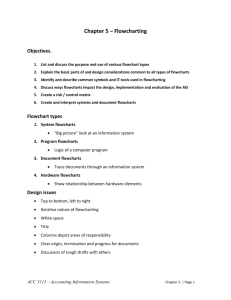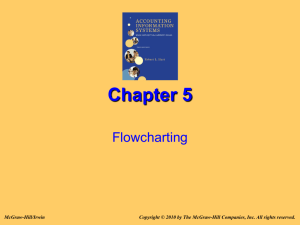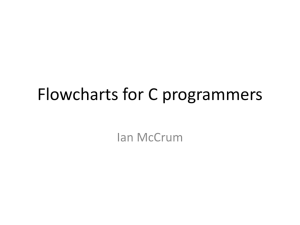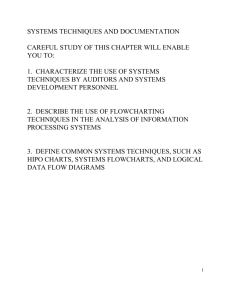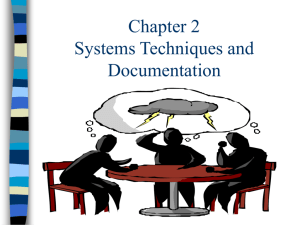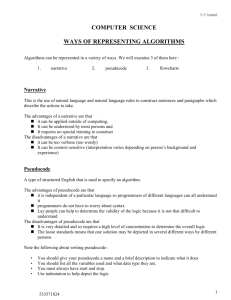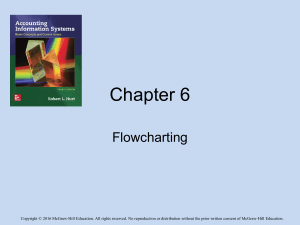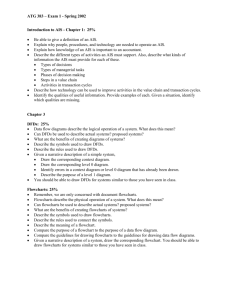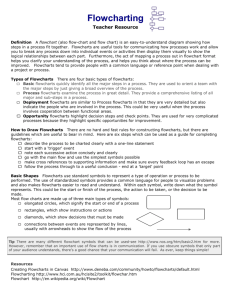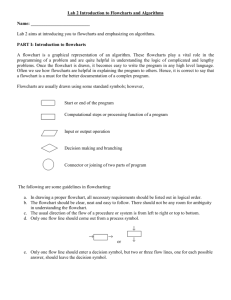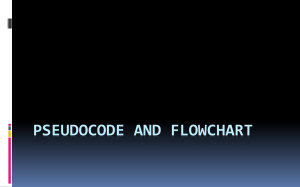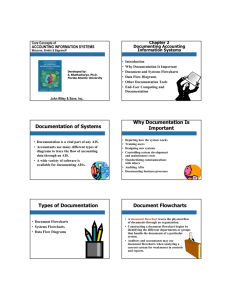Process Mapping for the City of San Antonio
advertisement
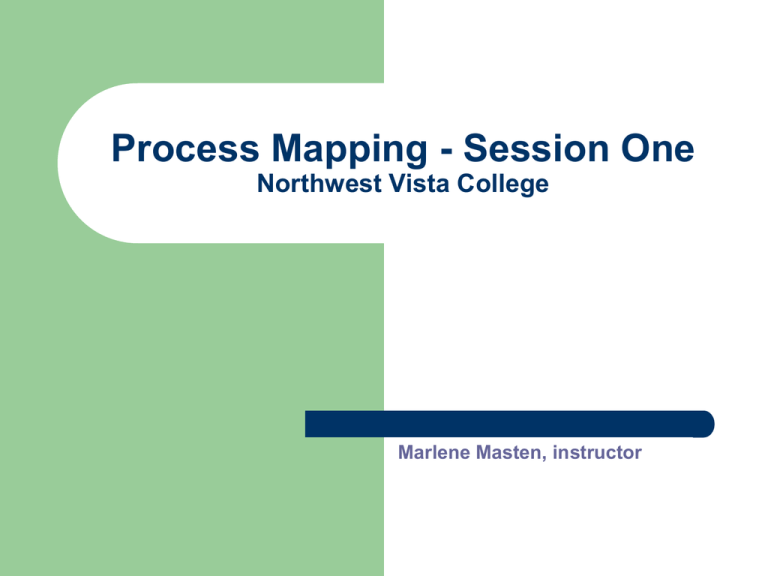
Process Mapping - Session One Northwest Vista College Marlene Masten, instructor Welcome! 2 A valuable tool An investment by your employer 4 hours with break(s) – get back on time! Instructor-led discussion, audience participation, activities, exercises Participant’s Guide – left margin for notes Glossary and Appendices – back of Guide Your Instructor 3 Marlene Masten Former teacher, past and current professional education and training Industrial engineer, project and personnel manager, consultant – more than 21 industries and 14 countries Current local business consultant and animal rescue volunteer Getting to Know You 4 Name? What department are you with? How long have you been with NVC / ACCD? What do you want out of this class? Course Objectives After this portion of the class, you will be able to: 5 Understand the benefits of process mapping. Identify different levels of processes (detailed versus high-level). Understand how to collect the data necessary for basic mapping – no small task! Course Objectives Achieved Through: 6 Your instructor’s skill and experience Hands-on experience Group and independent exercises Guide for reference Questions and answers Course Agenda 7 First Session Introduction and overview Defining what is a process and what is process mapping Mapping benefits Getting started Collecting data Course Agenda 8 Your Guide continues with: Opening the process mapping toolbox Choosing the right tool for the task at hand Analyzing the process Documenting findings Why Do All This? 9 Get a better understanding of your department’s processes. Focus on core processes and identify ways to improve. Enable all departments to use one tool and one consistent, continuous process when looking at how they provide services to meet their clients’ expectations. Focus your attention on wasted time and energy. Overview of the “Process Approach” 10 Enables client satisfaction and consistency Formal and disciplined – to identify, understand, manage the activities and elements required by clients Meet requirements 100% of the time Process Management 11 Teams who use this method: Understand “who” and “what” and “why” Document Measure Implement and improve Today’s Focus Documenting how work is done Allowing focus on core processes, enabling identification of opportunities for improvement Your Guide continues with more exercises & guidelines on two other mapping techniques. 12 Define “process” (p. 5) “A series of actions or operations which lead to an end” (Webster’s Dictionary) Example: What process is used to drive a car? Open door, sit, close door, foot to brake, seatbelt on, insert key, disengage parking brake … Are there any alternative steps or methods? 13 Define “process map” (p. 6) “A graphic representation of a process, showing the sequence of tasks, using standard flowcharting symbols” Standard, so anyone who picks it up can understand it. Document: – – 14 – What is really done What takes time What uses resources “Typical” Map LEGEND Railroad Government Bldgs High School Franklin St. Schools City Hall Thrid St. First St. Post Office Broadway Elementary School Winding Way Police Station Library Utopia Rd. Middle School 15 How can people get to work? Alternate paths possible? Benefits of Process Maps (p. 6) Objectively describe how activities are done Document control points (like intersections) Show where variation exists (how many routes are possible) 16 Investigate where problems may occur Highlight “handoffs” (go from one city to another) More Benefits of Process Maps 17 Train others on processes Develop process thinking Logically identify areas that need to be improved (and with proof!) Identify best practices Monitor and update the process when conditions change Review – Process Maps “A graphic representation of a process, showing the sequence of tasks, using standard flowcharting symbols” process map = “flowchart” a “visual picture” of a process 18 Example: Doing the Laundry 19 Flowcharts show: 20 Process as a whole Sequence of steps Relationship between steps Beginning and ending steps – the boundaries of the process Please answer the questions in your Guide, p.8-9 21 Common Types of Flowcharts (p. 1011) 22 Basic / Detailed (“Value Stream”) Swim Lane (“Deployment”) Spaghetti (“Transportation / Work Flow”) Flowcharting Highlights The basic steps are the same no matter what type of map you use. Strive for a level of detail that is useful to your project – no more, no less. Example: “sort clothes” isn’t helpful to someone new. You’d get pink laundry. 23 What to Map? Series of activities or steps contributing to the final result or output Start and end of a process (boundaries) Interfaces / transition points / handoffs Inputs & outputs “Ownership” Applies to every organization. 24 Note that boundaries lead to interfaces. Process Ownership Department? Individual? Who is responsible and accountable for the results? 25 Core, Sub, and Activity Level Processes CORE PROCESS SUBPROCESS ACTIVITY TASK 26 Possible to have one owner at each level Full definitions in Glossary Please answer the questions in your Guide, p. 12-13 27 The SIPOC Form A process snapshot that captures information that will help you determine where that process begins and ends. Process Supplier Client OUTPUT 28 Suppliers (internal or external, vendors or another dept), inputs, process, outputs, clients (internal or external) Creating a SIPOC Form 29 Identify process boundaries and key activities at a high level Identify key outputs and clients for each output Identify inputs and suppliers for each input SIPOC Diagram Format Supplier(s) Input(s) Core process Output(s) Client(s) 30 Please answer the questions in your Guide, p.15-16. Then discuss answers with the person next to you. 31 GROUP ACTIVITY Please close Guides. 32 Group Activity Wrap-up 33 Answer the questions on p. 17 in your Guide. How did it feel to wear a blindfold? Thoughts and feelings as moved around: navigator versus seeing impaired person? What did you wish your partner could have said to help you: navigator versus seeing impaired person? What did the observers notice about the interaction between the navigators and the seeing impaired persons? What could have been done to alleviate the navigator’s thoughts and fears? What could have been done to minimize the seeing impaired person’s degree of frustration? Group Activity Wrap-up Navigators had information – their partners did not. What does this exercise suggest about gathering information? Or even how to interview people about their work? 34 Interviewing Before mapping, you need to: Interview and/or watch the people actually doing the work Interview their supervisors and/or managers Leaders clarify scope, involved areas, types of measurement, rationale, and related information. But remember - NO JUDGMENT ALLOWED! 35 Data Collection: Performing Interviews 36 Ride-along – observe an individual and probe for more details versus Panel – get information from a group of people all at once Data Collection Matrix 37 Required in interviewing “Process Activity” = work being done “Input(s)” = materials, equipment, info, environmental conditions required “Output(s)” = product(s)/service(s) created or handed off “System(s)” = digital information accessed or reviewed to perform an activity “Reference(s)” = manuals, cheat sheets, etc., used to understand how to complete steps Data Collection: Ride-along Interviews DO: 38 Observe Take notes Ask for clarification, more detail Use Data Collection Matrix Watch for hidden steps (job aids, cheat sheets, etc.) Check often for understanding DO NOT: Make assumptions Add detail when it is not there “Correct” the process Data Collection: Panel Interviews 39 DO: Use checklist on p. 19 Facilitate by asking leading questions Give everyone a chance to participate Ask for clarification, more detail Check often for understanding Seek consensus Use Data Collection Matrix DO NOT: Make assumptions Add detail when it is not there “Correct” the process Get too caught up in the format – most people haven’t been trained to use this technique Panel Interviews 40 Use post-it notes for each person to put on blank flipchart, whiteboard, or table. Clean up – eliminate duplicates, combine similar ideas, agree on wording. Use consistent level of detail. Remember: You are only collecting information. NOT an audit, check for compliance - NO judgment Data Collection: Checklist 41 Planning ensures your time and your interviewees’ time is best spent. Use the checklists (p. 18, 19, & Appendix D) to make sure all of your bases are covered. Practice inquiry techniques (Appendix C) Review: Apply What We’ve Learned 42 Review Role Play: Apply What We’ve Learned 43 Part One Get into pairs and turn to p.20 Choose an interviewee versus interviewers Introduce yourself and the project’s scope Use verbal walk-through to get information Complete SIPOC Form Collect data using Ride-along interview method and the Data Collection Matrix Check for understanding Review Role Play: Apply What We’ve Learned 44 Part Two Record your group’s sub-process steps on sticky notes and put on classroom wall. Present your results to the class. 45 Exercise Check Inputs: • • • • • • • • • • 46 • Pot Stove Water Mac box Butter Milk Spoon Strainer Plate/bowl Measuring cup Sink Outputs: • • • • • • • • Mac ready to eat Empty box Dirty pan Dirty spoon Dirty pot Dirty strainer Dirty measuring cup Dirty water When Studying Any Process: 47 Define core process using SIPOC Form Interview / observe Complete Data Collection Matrix Map Analyze for accuracy Process Mapping Toolbox 48 CONSISTENCY All maps use the same basic steps. Flowcharts use symbols to represent different kinds of process steps. Common Flowcharting Symbols Direction of flow Starting, stopping, or control point Decision point Processing Input or output (optional) 49 *As a class, review flowchart in your Guide. 50 Decision Diamonds 51 Always pose a question – inspection or choice Lead to two or more paths Are best if you can put into yes/no format Use objective criteria, not subjective Basic Flowcharts with Detailed Steps Show: Sequence and relationship of steps Different types of actions with different shaped boxes Decision points Steps taken when things go wrong Most common type of flowchart 52 Use Basic Flowcharts When You Need To: Understand, improve, and standardize a process. Show sequence and relationships in detail. Identify where people are doing things differently Highlight decision points. Use when a SINGLE organization or person is responsible for most steps in a process. 53 Critical Components of Basic Flowcharts 54 Process name Date of creation or update (version) Name of person or group creating it (contact) Clear start and end points (boundaries) Clear direction flow Consistent level of detail Numbered steps Key of symbol definitions Basic Flowcharts - Steps 55 Clarify purpose Decide level of detail Write down all steps Decide start and end steps Arrange steps’ sequence Check for completeness Identify decision points (diamonds) Develop alternate paths for decision points Add flow lines and arrows Number each step *Tips for Basic/Detailed Flowcharts 56 Walk the process. Draw first drafts manually. Use numbered reference sheets. Always date or provide version #. Maintain version control. Create a “parking lot” folder. Concentrate on process, not symbols. Ask lots of questions. More Tips for Basic Flowcharts 57 Avoid confusion Identify contact(s) and boundaries Follow the flow and spot problems Note reference points Be sure it is easy to interpret 58 59 *Let’s Practice Once More Using the steps in your Guide and examples given in class, create a detailed flowchart for how to pay your credit card bill with a check (p. 29). Follow along in your Guide, using the instructions and all forms provided. 60 61 Detailed Flowchart Activity Debrief 62 It’s not easy to maintain a consistent level of detail. It’s not always easy to show different paths. Steps often need to be moved as you get clearer about the sequence. Numbering the steps is usually arbitrary. To Remember: 63 Selecting the start and end points provides boundaries for the flowchart. It’s easier to follow when it has a consistent level of detail. Be sure you make it clear where decisions are made in the process. Sequence is shown by flow lines and arrows. How Much Detail? 64 The more detail you have, the more information you have about how a process actually works. Lots of detail is necessary when it is absolutely critical the process be done exactly the same way each time. Weigh costs and benefits – detail takes time. Don’t get bogged down … or your users! Analyzing the Process 65 Review the categories of: Who, what, when, where, why People, material, machine, environment, methods Map to see where can improve Have redundant steps? Do things in parallel? Reduce customer wait time or cycle time? Map to document how things are done here Get right level of detail? Is it accurate? All Good Flowcharts Should Have: 66 Process name Date of creation or update (“version”) Name of person or group creating it Clear start and end points Clear direction flow Consistent level of detail Numbered steps Key of symbol definitions “Parking lot” folder See appendix checklist for reference. Remember the Steps 67 Review the process and its boundaries Identify chart type to use Have participants identify steps Use note/card per step, with chosen symbol Arrange steps in order Eliminate duplicates Determine and maintain consistent level of detail Number each step Transfer flowchart to paper or computer Check for completeness Wrap-Up 68 Final thoughts or questions? Thanks for coming!
